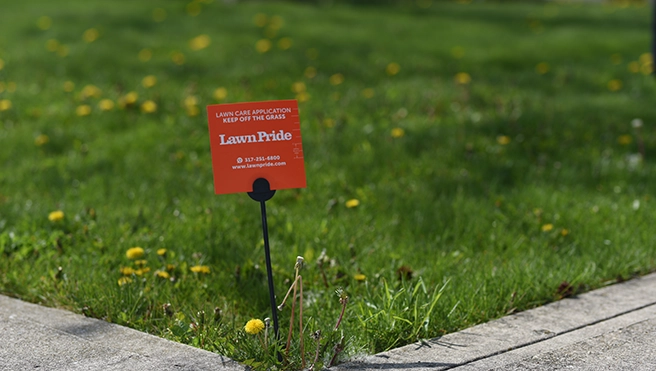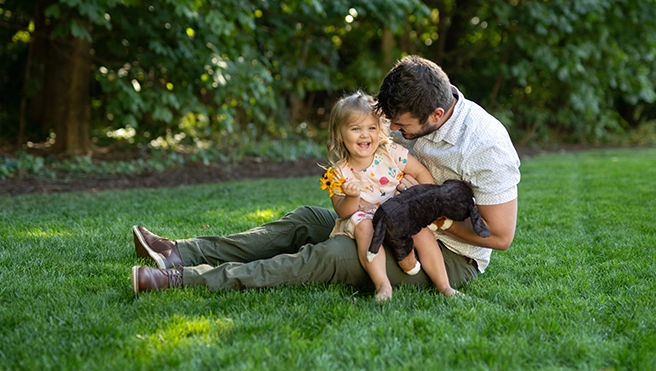As the leaves turn and the temperatures fall, your lawn’s needs change. Our comprehensive fall lawn care guide will take you through every step you should take during the autumn. season.
Fall Lawn Care: Tips & Best Practices
How to Maintain Your Lawn in the Fall

Cool-Season vs Warm-Season Grass

Preparing Your Lawn for Fall
Building up the health of your lawn’s roots is essential to ensuring it is ready for the cold months ahead.
Sharpen Your Mower Blades
Using a sharp mower blade is essential to getting a clean cut and protecting your lawn’s health. A dull blade makes ragged tears, stressing the lawn and leaving the grass blade ends open to grass fungus and pests.
Mow Tall
As long as your grass is actively growing, mow tall, leaving your grass about four inches tall. Taller grass develops thicker, deeper, more robust roots and provides more surface leaf area for photosynthesis. As your grass slows its growth and you prepare for your last mowing of the season, the final cut should be 2 to 2.5 inches.
Mow Often
Cool-season grass grows fast during the fall and should be mown frequently. As leaves start to fall, they can cause uneven cutting when too many are allowed to accumulate on the lawn before mowing. Increasing your mowing frequency during this season will help prevent this.
Don’t Bag
Grass clippings are one of the easiest ways to provide nutrients to your lawn. They break down quickly and return nutrients to the soil. Make sure the grass is dry, as wet grass clumps together and suffocates the grass growing beneath it.
Check out our Mowing Recommendations for a Healthy Lawn.
Watering Your Lawn
Next up in our fall lawn care guide is watering. Don’t assume that nature will take care of it for you. Your lawn needs water to thrive and survive. Watering too little or too much can harm your lawn. Your Lawn Pride® experts are here to help you find that balance.
When Should I Water My Lawn in the Fall?
The best time to water your lawn is in the early morning hours. Too much water sitting on the lawn overnight can lead to turf disease. Plan to water cool-season grasses twice a week unless you get adequate rainfall. Warm-season grasses need less water in the fall as they slow their growth and prepare to slip into dormancy for the winter. Water deeply, just less frequently.
Watering Techniques for Cooler Months
If you are a homeowner with an in-ground irrigation system, watering is as easy as programming your system correctly. However, not all homeowners have it that easy. Your cool-season lawn needs 1 to 1.5 inches of water per week, while warm-season lawns can do with 20% less water each week. Natural rain will do the trick, but it’s important to monitor your grass and water when there is no rain. This is the equivalent of watering for thirty to forty-five minutes twice a week.

Managing Leaves & Debris
Never let fallen leaves remain on your lawn. It suffocates the grass, blocks photosynthesis, and promotes fungus and mold. Raking or mulching leaves is an essential fall lawn care tip.
Leaves + Lawn Health
In the fall, nature sends loads of excellent (and free!) fertilizer for your lawn in the form of falling leaves. Don’t strain your back and deprive your lawn of vital nutrients. Instead, mulch the leaves. Your lawn will thank you. Most mowers can mulch the leaves for you. Mulching cuts the leaves into tiny pieces so they can quickly break down into the soil.

Weeds and Pests Control in the Fall
Weed and pest control are critical parts of your fall lawn care plan. Just as you must prepare your lawn for the coming winter, weeds and pests are also preparing for the cold season. With their decreased growth rate, warm-season grasses are more prone to pest and weed damage in fall than cool-season grasses.
Identifying and Managing Hard-to-Control Weeds
Fall is the time to tackle stubborn weeds like wild violets and ground ivy (a.k.a. creeping Charlie) in cool-season lawns. In warm-season lawns, perennial weeds like dandelions, clover, and dallisgrass become more prominent as the lawn’s growth rate tapers off. While these weeds can be weakened with broadleaf weed control throughout the year, they are most effectively controlled in the fall.
Grub Prevention and Treatment
Warm- and cool-season grasses unite in this fall lawn care tip — preventing and treating grubs. Fall is the time of year when grub damage can start to appear in lawns. Here are a few ways to tell if grubs are damaging your lawn.
Dead Grass
Turf may die for many reasons, and having grubs in your lawn is a primary culprit. Grub damage often appears as irregular brown patches in your grass. If these brown patches don’t green up despite watering or rain, you likely have grubs. These brown grub patches start showing up during the summer or early fall.
The Carpet-Roll
The most definitive way of diagnosing grubs is the carpet-roll method. If you suspect you have a grub infestation, grasp some of the browned grass and give it a gentle tug. If the grass comes up in one piece, then your issue is grubs. Grubs are below-ground insects that consume grassroots only, leaving the grass leaves, stems, and thatch intact. This test makes it relatively simple to diagnose once the damage has been done. Learn more about grub damage.
Effective Grub Control Measures
For natural grub control, there are a few effective options:
- Beneficial Nematodes: Apply these microscopic worms to the grass, and they will find their way to the soil. There, they infect and kill grubs. Nematodes are most effective when applied in late summer to early fall, targeting young grubs. Ensure the soil is moist during the application and remains well-watered for several weeks afterward to support nematode activity.
- Milky Spore Disease (Bacillus popilliae): This naturally occurring bacterium specifically targets Japanese beetle grubs. It's a long-term control method that takes a few years to become fully effective but can provide control for many years once established.
- Diatomaceous Earth (DE): Using food-grade DE, sprinkle the white powder evenly over dry brown or yellow grass where grub activity occurs. DE only works when it is dry and in direct contact with the grubs, dehydrating them. Reapply after rain or irrigation.
For effective grub control, contact Lawn Pride today.
Fall Lawn Fungus and Diseases
The next issue for our fall lawn care guide is protecting your grass from fungus and disease.
Common Fall Lawn Funguses and How to Prevent Them
Fall weather can bring turf diseases such as Red Thread and Dollar Spot to your lawn. These diseases can develop at any time of the year but are most common in the spring and fall when temperatures are cooler and rainfall is plentiful. Luckily, these types of lawn diseases can typically be treated with a simple nitrogen-rich fertilizer. However, in severe cases, a fungicide may be needed.
The Importance of Fall Aerating and Seeding
Aeration and overseeding are essential steps for maintaining a beautiful and healthy lawn. However, they factor into fall lawn care only for cool-season grass lawns.
Periodic lawn aeration is critical for your lawn’s health. The process removes many small plugs made up of soil, roots, thatch, and grass from throughout your lawn. Aeration opens up the root zone, promoting new and healthier root growth. Overseeding the lawn is best done immediately following aeration, as it puts the new grass seeds in direct contact with the soil.
Why Aerate Your Lawn in the Fall
Fall is the best time to aerate cool-season grass lawns, while spring is best for warm-season lawns. This timing ensures your grass is actively growing when the grass plugs are removed, limiting the stress on your lawn and ensuring it can recover quickly.
Choosing the Right Seed
Periodically overseeding your lawn keeps it lush and healthy. Whether fixing just a few bare spots or reseeding the entire lawn, choosing the right seed is critical. Choose a quality seed blend appropriate for your climate and your lawn’s makeup and sun exposure. Overseeding in the fall is ideal for cool-season grasses. Wait until late spring to reseed warm-climate lawns.
Lawn Maintenance Tips for A Healthy Lawn
Enhance Your Lawn with Professional Care
If our fall lawn care guide feels like too much to keep up with, we understand. Your local Lawn Pride delivers comprehensive and customized lawn care services to ensure the health and beauty of your lawn throughout the year.
You can trust the experts at your local Lawn Pride to keep your lawn looking its best because we’re invested in the beauty of your grass! We back this up with the Neighborly Done Right Promise®, which means your satisfaction is our highest priority.
Fall Lawn Care FAQs
Have more questions about fall lawn care? The lawn care experts at Lawn Pride have answers to some of the most asked questions about fall lawn care.
Our Special Offers
We understand your goal to keep your lawn looking its best. We take pride in your lawn because we know you do, too. Check out our special offers to see how you can save on your next lawn care application.
